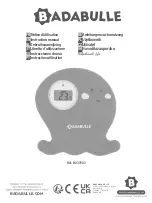
9
EN
When using the power station, you need only take care that
the point on the battery is in line with the point on the po-
wer station. When the battery is positioned, the magnetic
plug will attract it into place so that it will be electrically
connected. The LED display lights up to indicate successful
connection.
5.4 Connection/removal from charging unit
If you wish to charge without the power station, make note
of the symbols on the plug. As the plug is magnetic, it has
the advantage that it will only be attracted to the battery if
it is held the right way round. The LED display lights up to
indicate successful connection.
Charging of the battery is possible with and without power
station.
5.5 Charging the battery
Only charge the battery with the proper charging
unit. Using a diff erent charging unit may cause a
fire.
When using the charging unit for the first few
times a smell may become perceptible. This is
the result of a normal production process. If this
happens, make sure your work room is well aired.
There is no danger to your health.
The charger is designed for usage in damp-free,
dry and ventilated environment. Do not expose
the charger to rain or hot conditions.
You can charge the battery at any time without shortening
its life. There is no memory eff ect. Also, no damage to the
battery occurs when charging is interrupted.
The ideal temperature for charging is between 15 and
25° C (59–25° F). If the temperature of the battery is below
0° C (32° F), do not charge it. The upper temperature limit for
charging is 45° C (113° F). Please note: when the battery is
moved from very cold surroundings to a warmer place, you
must give it a certain time to adapt.
Remember that, aft er a sudden temperature
change from cold to warm, condensed water
can form on the battery contacts. To avoid this,
store the battery in the same place as where you
charge it.
• During a charging process, place the charging unit on an
inflammable surface and make sure that no easily inflam-
mable materials (for example paper, carton or textiles)
are located nearby. The charging unit warms up during
the charging process and there is a risk of fire while this
takes place.
• Do not use the charging unit in damp or wet places, or
near running water. There is a danger that the charging
unit will overheat, catch fire, or cause an electric shock.
To charge the battery, first insert the plug of the charging
unit from below into the power station. Then connect the
charging unit to a power outlet socket (line power).
First read the information on the charging unit
before using it (putting into operation).
Now you can connect the battery to the power station
Connecting the battery to the power station means that
charging has started. The LED display on the battery lights
up for 4 seconds in the color of the charging level selected
before continuing as a pulsating light. The LED display is ac-
tive in this way as long as charging lasts. Its color changes
according to the charging level. The LED display switches off
automatically when the battery is fully charged.
During charging, it is possible to switch off this pulsating
light of the LED display by pushing the ON/OFF button once.
Charging of the battery will nevertheless continue. The pul-
sating light is reactivated by pushing the ON/OFF button
once again; when the battery is fully charged, the display
may then light up with a green color for a short moment.
If the battery does not start charging aft er being connected
(for example charging unit not connected with power out-
let), the LED display shows a continuous light for 30 seconds
before going out.
Should the LED display show a blinking blue light, this me-
ans that the battery is outside its given temperature limits.
Make sure that the temperature of the battery is in a range
between 0° and 45°C (32°F–113°F).
5.6 Charging level indicator
LED display
Summary of Contents for Eco ePower300
Page 15: ...15 EN Own notes...


































